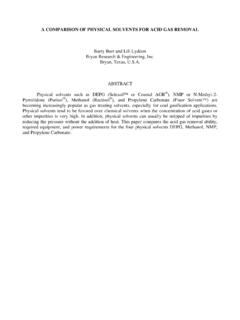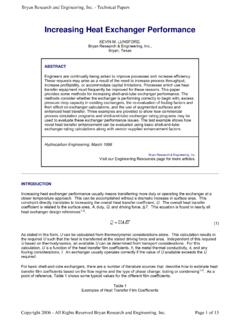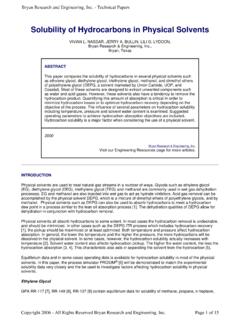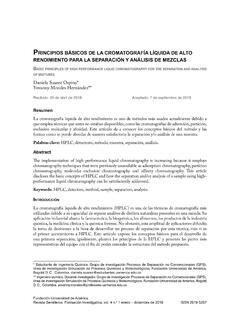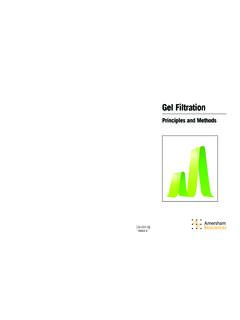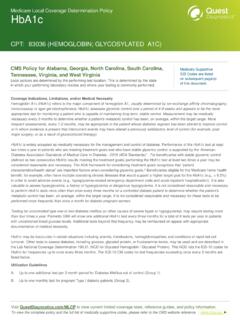Transcription of Analysis of Amine Solutions by Gas Chromatography - BR&E
1 Analysis of Amine Solutions by Gas Chromatography GARY D. ROBBINS, JERRY A. BULLIN, Chemical Engineering Department, Texas A&M University, College Station, Texas INTRODUCTION As energy prices continue to escalate, the performance and efficiency of all gas processing equipment becomes of critical importance. In many cases, performance evaluations are quite difficult due to the lack of convenient analytical procedures. This is especially true for Amine gas sweetening units where measurement of the acid gas and hydrocarbon content of the aqueous Amine solution is both problematic and time consuming.
2 Currently, the most popular analytical method for determining the acid gas concentration in aqueous Amine solution employs a wet chemistry titration. In the method for CO2, the Amine sample is mixed with an excess of standard base and heated to boiling. Since the Amine /acid gas complex is thermally unstable, the acid gas is converted into an ionic species and is precipitated by an appropriate metal salt. The filtrate is titrated with a standard acid to determine the concentration of uncarbonated Amine in the sample. Bromocresol green, cresol red and phenolpthalein are commonly used to indicate the end points [3,4,6 and 7].
3 The total Amine in the solution is usually determined by titrating the liquid sample with a standard acid in the presence of an indicator. Bromophenol blue, methyl orange and methyl red are used to indicate the end point in this titration [5,6,8]. The CO2 content of the solution is calculated as the difference between the total Amine and the uncarbonated Amine assuming a 1:1 stoichiometry between the Amine and CO2 [11]. Hikita et al. (1977) [6] has verified this stoichiometric ratio for the tertiary Amine TEA. The water content is most often determined by the Kieselbach Modification of the Karl Fischer method [5].
4 The end point is determined by an electronic detector and the method is applicable over wide ranges of water concentrations. The wet chemistry titration has a number of serious disadvantages. The total time required for an experienced technician to analyze one carbonated Amine solution could be as long as 1-1/2 hours. During part of this time, the CO2/ Amine solution is open to the atmosphere so both flashing of CO2 and degradation of the Amine can occur. Several problems are also encountered when attempting to sample Amine solution streams under pressure.
5 ABSTRACT Currently, the most common method to analyze for acid gases in Amine Solutions is by wet chemistry titration which is both tedious and time consuming. A simple gas chromatographic method now exists which is accurate and performs one Analysis within eight minutes. Energy Progress December 1984: 229-32. Bryan Research & Engineering, our Engineering Resources page for more articles. Bryan Research and Engineering, Inc. - Technical PapersPage 1 of 8 Copyright 2006 - All Rights Reserved Bryan Research and Engineering, , significant flashing will occur in most cases when the pressure is released on rich Amine Solutions .
6 Freshly prepared Solutions of standardized acid and base must also be available and verified daily before use. Blank runs should also be made to properly execute the titration. The solution Analysis by titration is often complicated by the presence of impurities and degradation products. Some of the degradation products cannot react with the acid gases but are titrated as carbonated Amine . Other degradation products are heat stable salts which are also titrated as free Amine [1]. Most chemical methods of ethanolamine Analysis depend on Amine functionality and are often nonspecific and inaccurate [2].
7 Wisniewski (1961) [12] devised a GC technique which could analyze for amines on one column and the acid gases and H2O on another column but could not analyze for all components with a single sample injection. When analyzing for the acid gases and H2O, the column was pretreated with an injection of HCl. The HCl scrubbed the Amine from the sample and allowed the acid gases and H2O to elute for Analysis . The saturation of the column with Amine made reproducibility difficult. All of the above methods for analyzing aqueous Amine Solutions have one or more major difficulties and none of the methods can analyze for all of the components in the solution.
8 In the present work, significant advances have been made on a GC method to analyze for acid gases, hydrocarbons, water and Amine content of aqueous Amine Solutions . DEVELOPMENT OF THE GC METHOD In developing the GC method, several problems were anticipated. First, ethanolamines are very reactive compounds. The polar hydroxyl and Amine groups have a strong adsorption affinity for silaceous column supports. The success of a stationary liquid support was improbable due to the strong physicochemical interactions and slow diffusion of the amines through the liquids.
9 However, Saha et al. (1977) [10] have shown that a short column with Tenax-GC packing can be used to analyze MEA, DEA, TEA and their impurities. Sharp distinct peaks with good separation were obtained in less than 8 minutes using a Perkin-Elmer model 900 gas chromatograph with a flame ionization detector. Tenax-GC is an organic polymer bead with a very weakly interacting surface permitting rapid mass transfer, fast elution and sharp peaks and is reported to have excellent thermal stability [9]. A second potential problem was the formation of thermal degradation products at high column temperatures in the GC.
10 However, Saha et al. (1977) [10] reported that alkanolamines do not undergo rapid thermal decomposition at injection port temperatures up to 375oC. The degradation of amines is probably more a function of time than of temperature. In a GC, the time spent on the columns is very short so degradation is insignificant. A third problem with analyzing the components in Amine Solutions was their tremendous range of boiling points from -80oC for CO2 to 250oC for MDEA. Thus an isothermal column oven could not be used and a rapid temperature program was needed for a short elution time.
